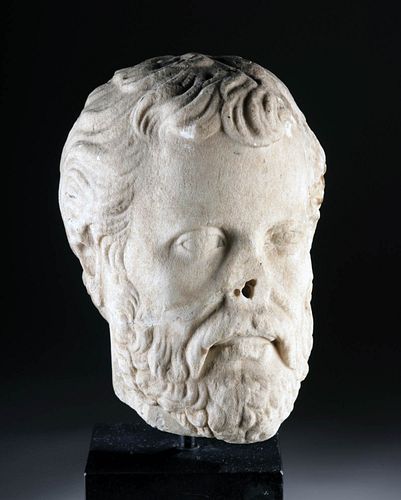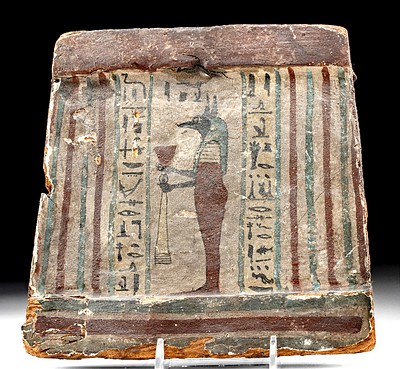Near-Lifesize Roman Marble Head of a Philosopher
Lot 27c
About Seller
Artemis Gallery
686 S Taylor Ave, Ste 106
Louisville, CO 80027
United States
Selling antiquities, ancient and ethnographic art online since 1993, Artemis Gallery specializes in Classical Antiquities (Egyptian, Greek, Roman, Near Eastern), Asian, Pre-Columbian, African / Tribal / Oceanographic art. Our extensive inventory includes pottery, stone, metal, wood, glass and textil...Read more
Categories
Estimate:
$22,000 - $33,000
Absentee vs Live bid
Two ways to bid:
- Leave a max absentee bid and the platform will bid on your behalf up to your maximum bid during the live auction.
- Bid live during the auction and your bids will be submitted real-time to the auctioneer.
Bid Increments
| Price | Bid Increment |
|---|---|
| $0 | $25 |
| $300 | $50 |
| $1,000 | $100 |
| $2,000 | $250 |
| $5,000 | $500 |
| $10,000 | $1,000 |
| $20,000 | $2,500 |
| $50,000 | $5,000 |
| $100,000 | $10,000 |
| $200,000 | $20,000 |
About Auction
By Artemis Gallery
Aug 26, 2021
Set Reminder
2021-08-26 10:00:00
2021-08-26 10:00:00
America/New_York
Bidsquare
Bidsquare : Fine Antiquities | Asian | Ethnographic Art
https://www.bidsquare.com/auctions/artemis-gallery/fine-antiquities-asian-ethnographic-art-7366
Features classical antiquities, ancient and ethnographic art from cultures encompassing the globe. Egyptian, Greek, Roman, Etruscan, Near Eastern, Asian, Pre-Columbian, Native American, African / Tribal, Oceanic, Spanish Colonial, Russian, Fine / Visual Arts, so much more! Artemis Gallery info@artemisgallery.com
Features classical antiquities, ancient and ethnographic art from cultures encompassing the globe. Egyptian, Greek, Roman, Etruscan, Near Eastern, Asian, Pre-Columbian, Native American, African / Tribal, Oceanic, Spanish Colonial, Russian, Fine / Visual Arts, so much more! Artemis Gallery info@artemisgallery.com
- Lot Description
Roman, Imperial Period, ca. late 1st century CE. Finely carved from a single piece of white marble, the head of a bearded male with features that are remarkably naturalistic: thick-lidded almond-shaped eyes, an arched browline that once led to his nose (now missing), deep nasolabial folds framing his thick mustache, a full beard framing the lower half of his face to his jutting chin, and a thick head of wavy hair crowning his high forehead. Size: 8.75" L x 8" W x 10.875" H (22.2 cm x 20.3 cm x 27.6 cm); 17.25" H (43.8 cm) on included custom stand.
The short beard style that we see on this portrait became popular by the early 2nd century CE; coinciding with the resurgence of Hellenism under the emperor Hadrian (117 to 138 CE). During the years prior to Hadrian, facial hair was regarded as a trait belonging to so-called barbarians. Perhaps the most famous monument depicting this is Trajan's column (113 CE) which presents the Dacians with full beards. The era of Hadrian, however, saw the rise of bearded imperial portraits intended to emulate the Greek philosophers.
A very similar bust was listed in Sothebys, New York - June 25, 1992 - Lot 129.
Provenance: ex-private Leit collection, Los Angeles, California, USA, acquired in London and imported to the USA in 1986
All items legal to buy/sell under U.S. Statute covering cultural patrimony Code 2600, CHAPTER 14, and are guaranteed to be as described or your money back.
A Certificate of Authenticity will accompany all winning bids.
PLEASE NOTE: Due to recent increases of shipments being seized by Australian & German customs (even for items with pre-UNESCO provenance), we will no longer ship most antiquities and ancient Chinese art to Australia & Germany. For categories of items that are acceptable to ship to Australia or Germany, please contact us directly or work with your local customs brokerage firm.
Display stands not described as included/custom in the item description are for photography purposes only and will not be included with the item upon shipping.
#147478Repaired from about 3 to 4 large pieces with restoration over the break lines. Losses to nose, neckline, and high-pointed areas of coiffure, ears, browline etc. Expected surface wear commensurate with age. Traces of mineral deposits across the surface. Large drilled hole behind head, presumably for attaching to another element.Condition
- Shipping Info
-
All shipping is handled in-house for your convenience. Your invoice from Artemis Gallery will include shipping calculation instructions. If in doubt, please inquire BEFORE bidding for estimated shipping costs for individual items.
-
- Buyer's Premium



 EUR
EUR CAD
CAD AUD
AUD GBP
GBP MXN
MXN HKD
HKD CNY
CNY MYR
MYR SEK
SEK SGD
SGD CHF
CHF THB
THB

















